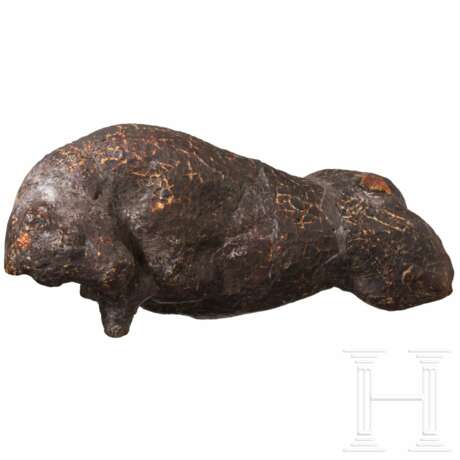ID 1323268
Lot 4057 | Bernsteinfigur eines liegenden Stiers, griechisch, 4. Jhdt. v. Chr.
Liegender Stier mit zur linken Seite einwärts geneigtem Kopf und mächtigem Nacken und Rücken. Die Vorderläufe angewinkelt, auf dem rechten Vorderlauf liegend, den linken zu Boden fallen lassend. Von den Hinterläufen nur die Oberschenkel erhalten, die Unterschenkel wohl ehemals in Richtung Kopf eingeknickt. Die Gestaltung der Anatomie lässt das Stück gut in das vierte vorchristliche Jahrhundert datieren. Insbesondere die Kopfhaltung und die Stilisierung von Nacken und Rücken lassen sich gut mit berühmten Stierskulpturen gleicher Zeitstellung vom Kerameikos oder aus Oreos vergleichen, wenngleich diese stehende Stiere darstellen. Das Stück war in seiner Geschichte bereits vor längerer Zeit aus Bruchstücken zusammengesetzt worden und wurde einer fachmännischen Restaurierung unterzogen, bei welcher die alten Klebungen gelöst und die Teile neu zusammengefügt wurden. Nur geringfügige Absplitterungen an den Bruchkanten der erhaltenen Teile ergänzt. Äußerst seltene und hochwertige Kleinskulptur der späten griechischen Klassik. Länge 28,3 cm.
Provenienz: Süddeutsche Privatsammlung. In den 80er Jahren übernommen aus dem Besitz des Vaters.
An amber figure of a lying bull, Greek, 4th century B.C.
An amber figure of a lying bull, Greek, 4th century B.C.
Lying bull with head tilted inwards to the left side, with strong neck and back. The forelegs angled, lying on the right foreleg, letting the left one fall to the ground. Only the thighs of the hind legs are preserved, the lower legs probably once folded towards the head. The design of the anatomy allows the piece to be dated to the 4th century B.C. In particular, the position of the head and the stylization of the neck and back can be compared well with famous bull sculptures of the same period from the Kerameikos or Oreos, although these depict standing bulls. The piece had previously been restored using unsuitable glues, that later on broke apart again. Thus it was professionally restored, removing old bonding, properly reassembling the fragments. Only minor chips on the broken edges of the preserved parts have been repaired. Extremely rare and high-quality small sculpture from the late Greek classical period. Length 28.3 cm.
Provenance: German private collection. Taken over from the father's property in the 80s.
Condition: III
| Place of origin: | Ancient Greece |
|---|
| Place of origin: | Ancient Greece |
|---|
| Address of auction |
Hermann Historica Bretonischer Ring 3 85630 Grasbrunn / München Germany | ||||||||||||||
|---|---|---|---|---|---|---|---|---|---|---|---|---|---|---|---|
| Preview | |||||||||||||||
| Phone | +49 (0)89 5472 649 0 | ||||||||||||||
| Fax | +49 (0)89 5472 64999 | ||||||||||||||
| Buyer Premium | 25 % | ||||||||||||||
| Conditions of purchase | Conditions of purchase | ||||||||||||||
| Business hours | Business hours
|



